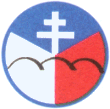

In 1944, the B-534's of the Letecká skola Slovenskych vzdusnych zbraní (Air School of the Slovak Air Arm) became an important part of the combat strength of the Kombinovaná letka (Combined Squadron), representing the complete air power of the Slovak National Uprising before the 1st Czechoslovak Fighter Regiment in the USSR arrived. The well-worn and often expired Slovak machines were made combat worthy and maintained by frequent cannibalising of other less well off airframes. The Command of the 1st Czechoslovak Army in Slovakia asked the Soviet authorities to return back the B-534.158, .181, .364 and the Bk-534.512 from the Army Air Group, however, unlike the two Bf 109 G's, two S-328's and one Fw 198 A, they were not flown back.
The Combined Squadron had on its strength the B-534.217, the .325 and at least two other machines of this type. They where used for light bombing missions, ground attack/strafing missions and there are reports of use for fighter escort on S-328 missions.
On 2 September 1944, Stábni rotmistr (Master Sergeant) Frantisek Cyprich was asked to perform a test flight of Avia B-534.217, which had been repaired and armed by the Maintenance Unit at Tri Duby airfield, which was the base for the Combined Squadron.
He made a short test flight but on returning to the airfield, he saw all the personnel on the field running into shelter and he understood that an enemy aircraft was approaching. This was nothing new since German aircraft attacked the airfield daily. Harmless Ju 52 transports also daily overflow the airfield but since the personnel on the ground didn't know which kind aircraft that was approaching it was better to be safe than sorry and seek shelter.
Since Cyprich's aircraft wasn't equipped with a radio he tried to find the enemy by himself but saw only empty skies. He thought that he had missed it and landed at the airfield boundaries where there were personnel sheltered in trenches.
When he landed he saw that everybody pointed towards a small dot in the sky - the enemy aircraft!. He took off again and overhauled it. He later reported:
"I had overtaken the Ju 52 over Radvana. I made the first attack from behind - it filled my aim cross - it was in front of me, big as a barn. I was sure that all my bullets would go into the Ju 52 but I realised that I must do another type of attack. When I made the second attack, I aimed at one engine and opened fire until I saw smoke coming from the engine. Then I made the same attack against the second engine and after that I saw the Ju 52 coming down. I was very happy that I shot down the first enemy plane during SNP and I was very proud when I landed on our own airfield."He landed back on base and went to report to Colonel Singlovic. He was however surprised, when he saw instead of his smile only his strict sight. The colonel only had one question:
"Why you didn't force them to land on our base?"Cyprich realized that the colonel was right. An undamaged Junkers could have been very useful for the Combined Squadron but now it was only a heap of metal near Banska Bystrica. Cyprich was sorry that he didn't remembered this possibility, but other people on the base was happy that he had shot it down!
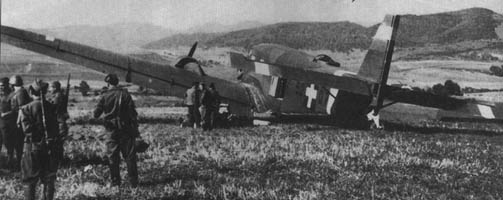
Pilot on the Junkers that Cyprich shot down was föhadnagy (Lieutenant) György Gách, who had taken off on 1 September 1944 in a Hungarian Junker Ju 52/3m from Magyar Légiforgalmi Rt. (MALERT). Gách (who today lives in New York) later reported:
"On 1 September 1944 I flew with a Ju 52 from Kolozsvar [today Cluj in Romania] to Budapest. When we were over Big Hungarian lowlands our plane flew into dense clouds and then into a strong thunderstorm. We had to make an emergency landing. When the thunderstorm finished we took off again and landed on the Budaörs airport without problems.Despite having as free day, Gách boarded the plane and sat down on the left captain seat. Both the Staff Officers and the rest of the passengers were already seated. In the aircraft were also mailbags and three barrels with 100oktan air-petrol C4. The rest the crew was members of Oszlányi's crew and consisted of the co-pilot föhadnagy Nándor Vermes, the wireless operator Imre Maszlagi and the flight engineer örm. Lázló Széky. Vermes gave a sign and the unarmed Junkers took off with course towards Krakow in excellent weather.
Next day, on 2 September 1944, I was woken up at 8.00 AM by the wireless operator of MALERT company, Imre Maszlagi, who told me, that I had to immediately go to the airport. We took a motorcycle and after short time we arrived at the airport. Already waiting there was százados [Captain] Ferenc Gelencsér, századparancsnok [Flight Leader] of 102/1. futárszállító század [transport flight]. He pointed at the runway where Ju 52/3m marked S.2 + 07 was standing with running engines [this aircraft was produced at the PIRT factory]. Százados Gelencsér told me, that the százados of this plane, Zoltan Oszlányi, had gone down with probably food poisoning and he was not fit to fly. In the plane were two high Staff Officers and five other passengers, who were waiting for start. Destination airport was the Polish town of Krakow."
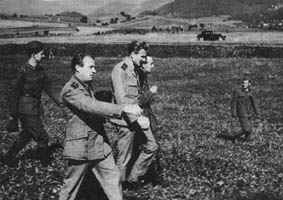
After they were captured, a Lieutenant who spoke Hungarian guarded them in quarters at Banska Bystrica. After some time they were transported to a prisoners camp. During this transport, a German Fw 189 attacked them and they ran into a forest. Here they changed their clothes for Slovak uniforms and they went towards the Hungarian frontier. At the border, Hungarian soldiers captured them and after the check of their identity, they were transported to Budapest.
This was the first victory of the Slovak National Uprising and the last confirmed air to air kill by a biplane fighter in the Second World War.
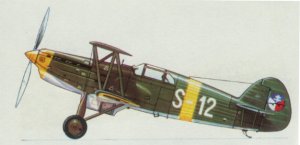
In the afternoon on the same day (2 September), rtm. let. Ján Lupták flew a sortie in an Avia B-534 to explore the communications between Svatý Mikulá and Poprad.
Over Poprad air base, he saw three German Junkers Ju 87 As, which he immediately attacked. He returned claiming damaged to all three.
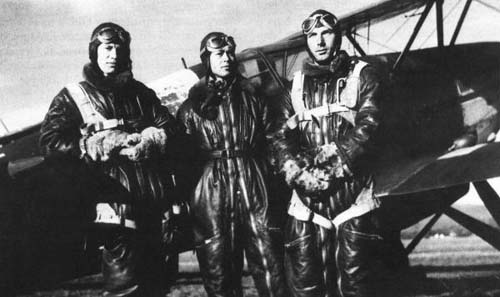
After the arrival of the 1st Czechoslovak Fighter Regiment in the USSR, equipped with its modern Lavochkin La-5FN's, on 17 September 1944, the obsolete and worn machines of the Combined Squadron were not so urgently needed in combat as before. After necessary repairs they nevertheless flew occasionally and two of the B-534's survived until the end of the Uprising, when, on 25 October 1944, they were set on fire as the Tri Duby airfield was evacuated.
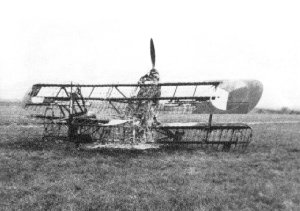
Sources:
Air Aces Home Page - Jan Safarik
Avia B-534 - Jirí Vraný, 1994 MBI, Praha, ISBN 80-901263-6-7
Ceskosloventí letci v boji proti faismu Zdenek, 1987 Nae vojsko kindly provided by Jan Safarik.
Hrdinstvo je, ked J. Modrovich,1969 Letectví + kosmonautika, No. 17 kindly provided by Jan Safarik.
Letectvo v prípravách na ozbrojené vystúpenie a jeho úcast v SNP - Ján Stanislav, 1996 VEDA, Vydavatestvo Slovenskej akademie vied, Bratislava kindly provided by Jan Safarik.
Poslední let S.2+07 - Martin Fekets, 1999 Revi no. 28 1999 kindly provided and translated by Pavel Vancata
Additional information kindly provided by Jan Safarik and Pavel Vancata.
